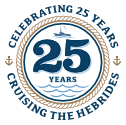After several years of bad news on seabird populations on the west coast of Scotland, Dr Richard Luxmoore, Senior Nature Conservation Adviser for the National Trust has reported that several species have had their best season in 10 years.
The National Trust for Scotland’s studies on their property at Mingulay, showed that there were 1642 pairs of Kittiwakes trying to nest, up 46 per cent since last year. More importantly, their breeding success, at 88 chicks produced per 100 pairs, was much better than 2013. Other species, such as Razorbills, Common Guillemots and European Shags also recorded substantial improvements in both numbers and breeding success.
Studies carried out by the Highland Ringing Group on Canna, in the Small Isles, showed that Kittiwakes were up 14% since last year and also had excellent breeding success, similar to its near neighbour Mingulay across the Minch. Guillemots and Razorbills also experienced better breeding success and higher numbers than in recent years. More excitingly, researchers located five occupied nest burrows of Manx Shearwaters at three locations around the island. Shearwaters had been reduced to local extinction on Canna but a successful rat eradication project, completed in 2006, has allowed them to recolonise several of their former nest sites.
On St Kilda, annual monitoring has shown that Puffins have had much greater breeding success than in recent years. Also a ground-breaking programme to study the elusive and little known Leach’s Storm-petrel has been able to take detailed measurements of three chicks that have been reared in artificial nest burrows this year.
Conservationists hope this rise in populations will not be just a blip in a long-term decline of our seabirds and provides a boost to colony sizes for several years to come.
Scotland is internationally important for its seabirds, having some 45 per cent of the breeding population in the whole of the European Union. The National Trust for Scotland hosts almost a fifth of these at is properties of St Kilda, Mingulay, Fair Isle, Canna, St Abbs, Iona, Staffa and Unst.


























This trip exceeded our expectations despite the mixed weather - this is Western Scotland after all! For John a highlight was the sighting of a corncrake which means Judi can no longer tease him that she had seen them before. Stevies cooking was excellent and Chris, Craig and Nigel showed a fine level of local knowledge. We would have no hesitation recommending you to others and may well book another trip with you.
John and Judi Friend: 28 April 2018